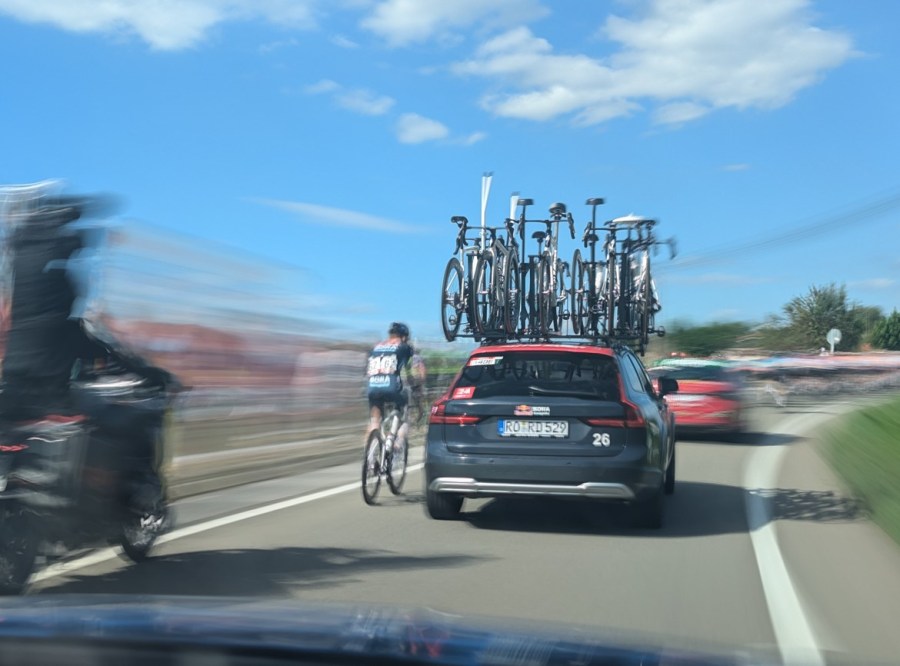On of the best things about Grand Tours like La Vuelta – from a fan’s perspective – is the chance to line the roadside and watch your cycling heroes for free. It puts you within touching distance of some of the biggest names in the sport. You can teeter by the side of the road in your cycling shoes, dress up as a dinosaur or don a mankini if the mood takes you. You can even run alongside them waving a flare like a maniac. (Actually, don’t.)
The only problem is that the race can pass by in a flash. The cavalcade of outriders at the front and teams cars at the back often take more time to drive past the vantage point you may have been holding for hours than the peloton themselves. And unless you’re on a mountain-side the riders will pass in a such a blur of color that distinguishing individual riders can be all but impossible.
Which is why I jumped at the opportunity to ride in the Shimano neutral service vehicle during Friday’s stage 19 of La Vuelta 2024. Not only would that mean I’d be within touching distance of the race from start to finish; if any rider had a crash or mechanical and their team car couldn’t get to them, I could actually be involved in it.

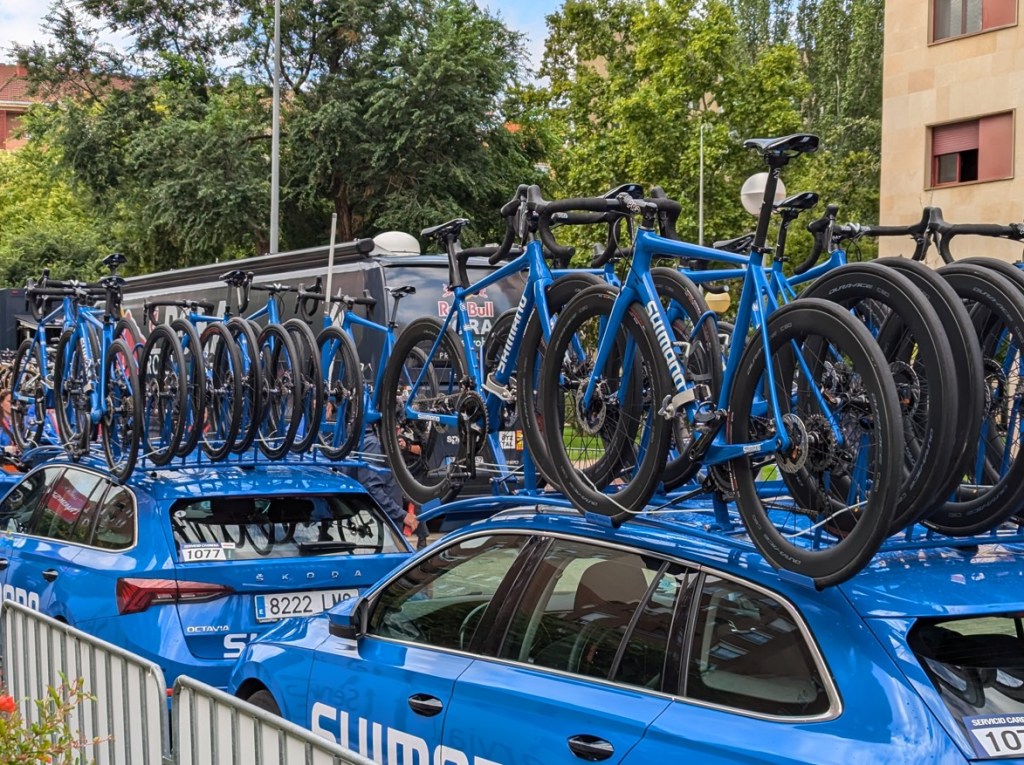
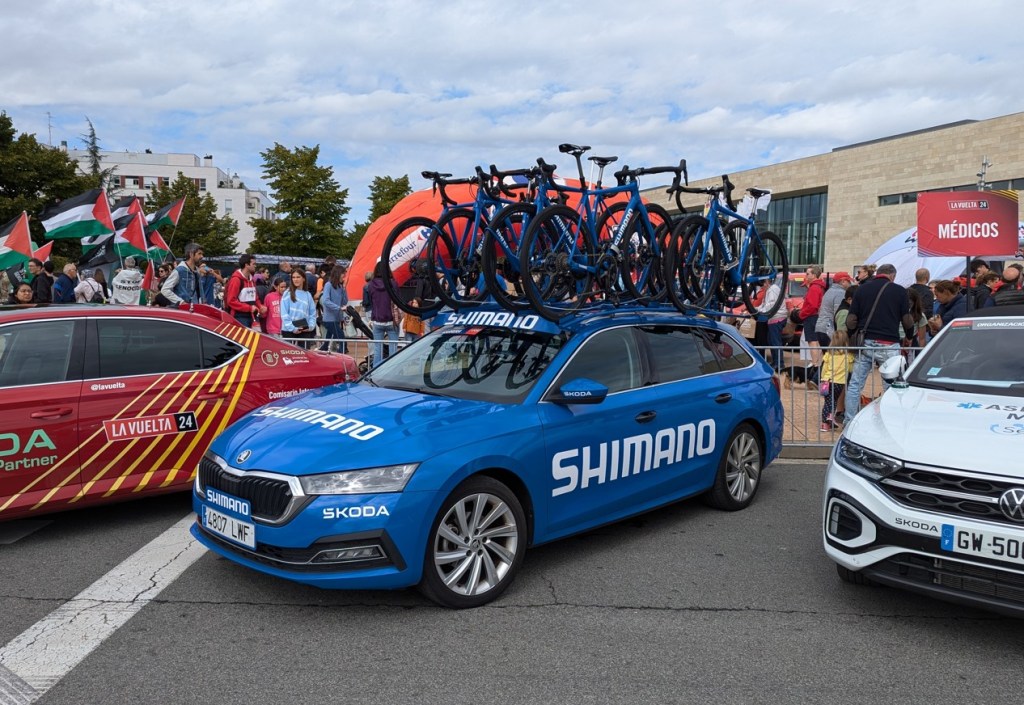
In the Shimano neutral service car at La Vuelta
Shimano works in collaboration with Grand Tour organiser ASO to provide neutral service for the riders on races such as the Tour de France, the Tour de France Femmes avec Zwift, La Vuelta and La Vuelta Femenina by Carrefour.es, as well as numerous Classics races.
Half an hour before the neutralised start of stage 19 – which ran from Logroño to Alto de Moncalvillo in the mountainous northwest – I’m introduced to the Spanish Shimano team and squeeze into a bright blue Skoda packed to rafters with spare wheels and kit. My hosts for the day – the driver next to me and mechanic behind – speak as much English as I do Spanish (i.e. none). However they welcome me smiling into their office.
There are three such Shimano cars in the race today, as well as two motorbikes. The bikes just carry spare wheels; the cars have wheels in the back and a vast collection of spare bikes on the roof. These bikes are kitted out with all the teams’ pedal systems and are mostly medium or large (unlike the teams’ bikes they are fitted with dropper posts to dial in the best fit on the fly).
The Shimano team carry a spec sheet with each of the 180 riders’ complete bike specifications. So in an emergency they can quickly select the best kit to get the rider back on the road. It’s very rare that a racer will cross the finish line riding one of these unmistakeable blue Shimano stock bikes. Once their team car catches up to them they’ll usually swap it for their own correctly-specced spare bike. Any time a rider loses swapping bikes is normally made up quickly by riding a machine tailored to them.
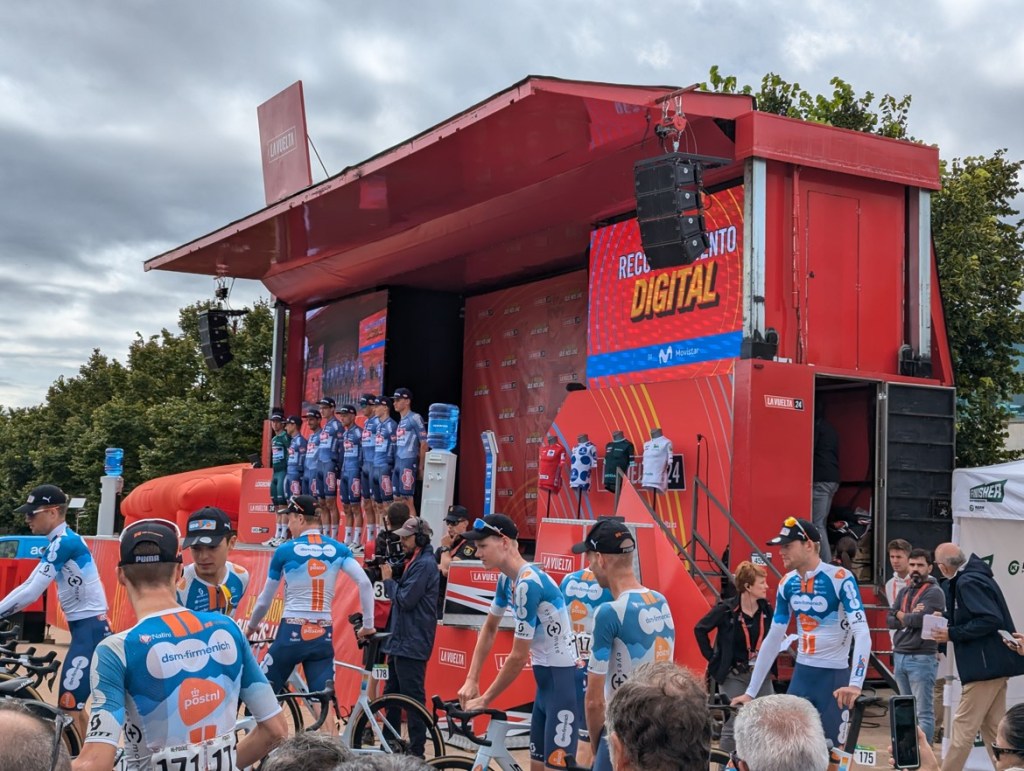
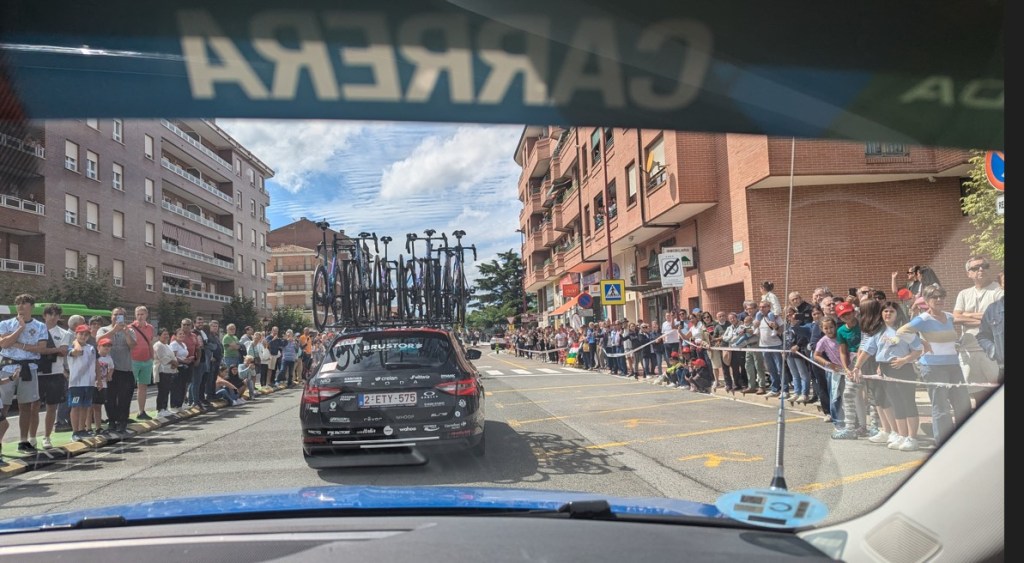
La Vuelta neutralized start
We soon roll out through the crowded streets of Logroño. The throngs of cheering fans line the roadside for a good mile out of town. Each time we enter even the smallest hamlet they instantly reapper. Many have set up trestle tables by the side of the road and are clearly in for the duration. Feasts have been prepared and local wine is flowing freely. Many kids on parents’ shoulders hold signs requesting riders’ bottles. It’s a bit like football fans asking for players shirts but these trophies won’t fetch quite so much on eBay.
I can now hear the thrum of the television helicopters overhead. The race is on.
At this point we’re quite far back in the cavalcade. Still, it’s the perfect vantage point to soak up the festival atmosphere. The crowd seem to treat the convoy of team cars, race officials, camera bikes and medical vehicles with almost the same adulation they do the riders. Whistles, klaxons and cow bells pierce the general hubbub as we pick up speed out of town. Race radio crackles into life informing the team (in Spanish, English and French) that the race proper is under way. Immediately the pace picks up to about 50km/h. It will barely drop below this for the next four hours.
The team in my car operate like a well-oiled machine. Without speaking, the mechanic in the back hands out foil-wrapped tuna rolls and towels, which they both lay across their laps to stop their pristine vehicle getting messy. They offer me one too and I dutifully do the same. The driver’s eating with just one palm resting under the steering wheel, often turning to chat to his colleague. They’re clearly done this hundreds of times before.
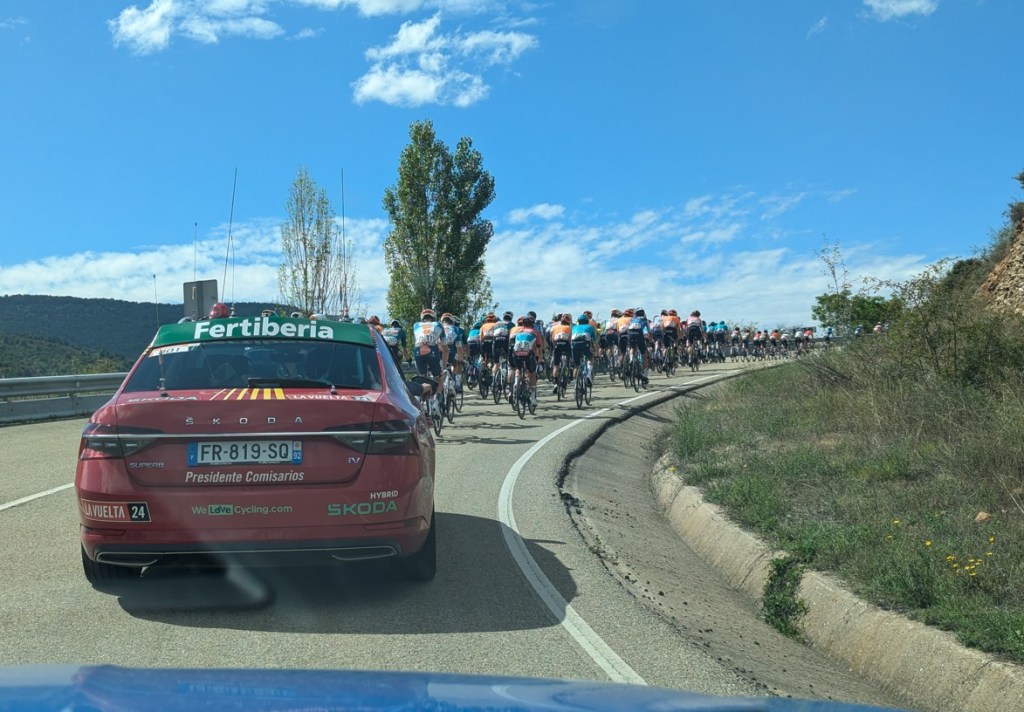
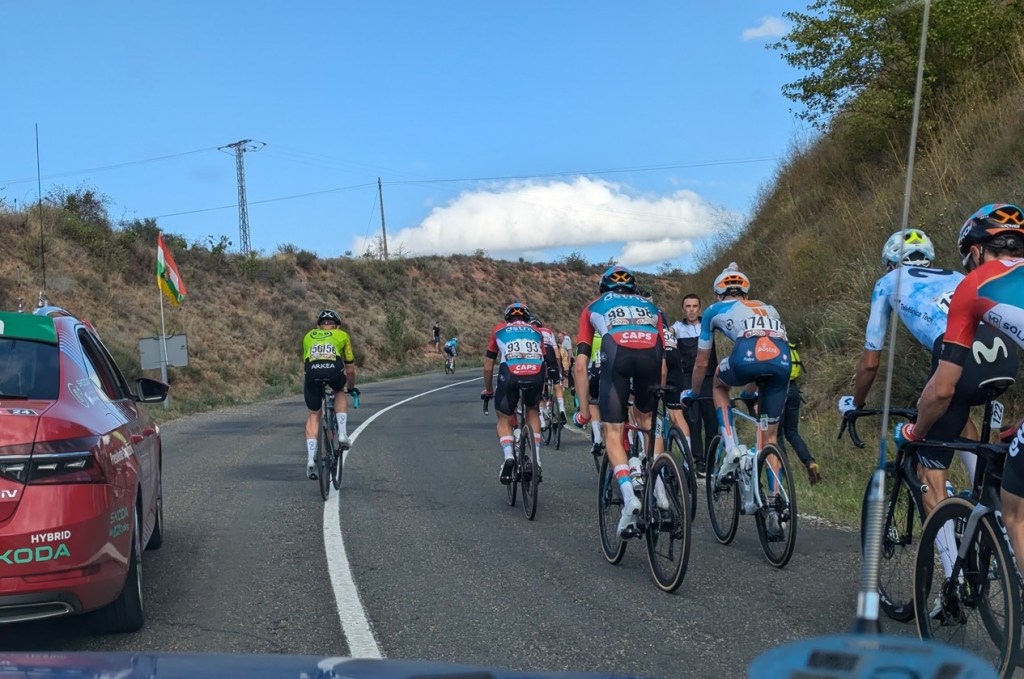
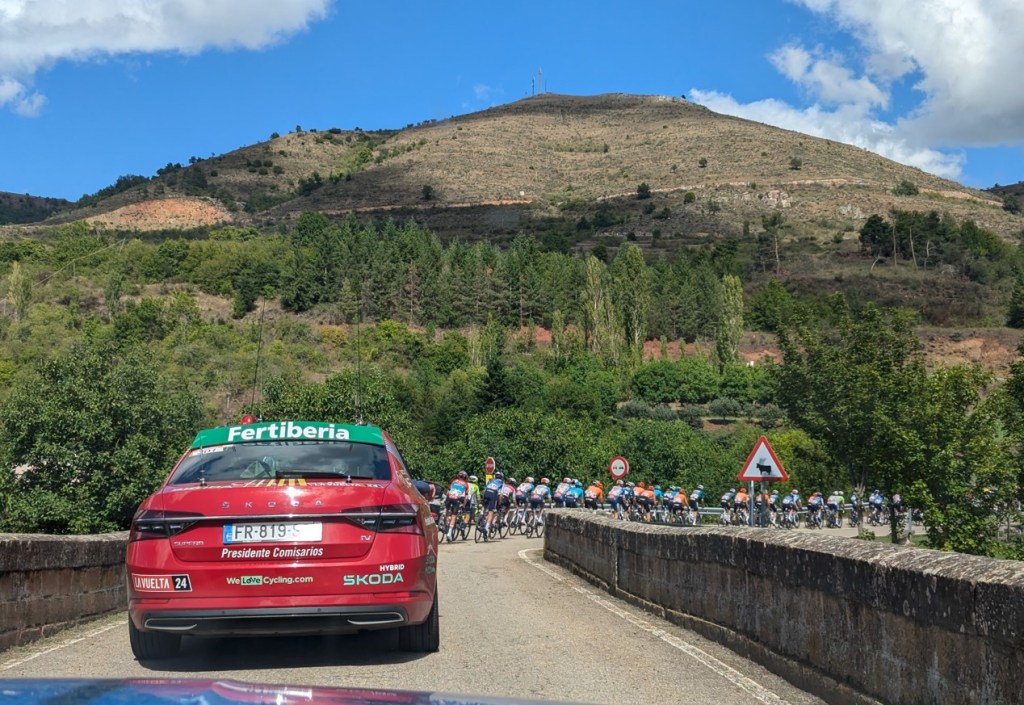
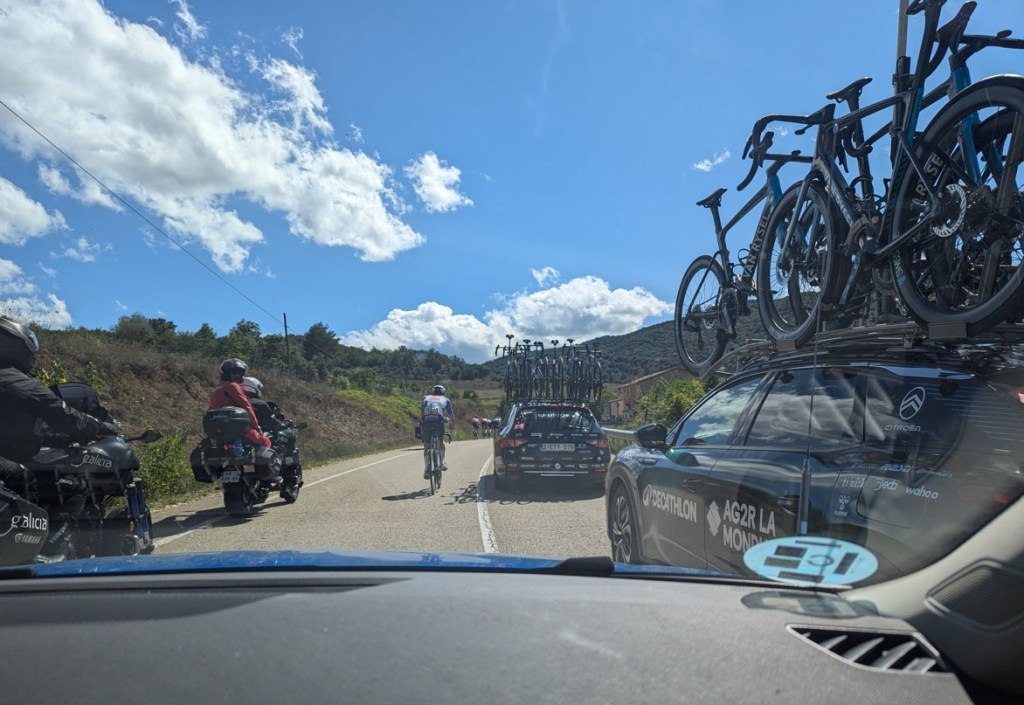

In the thick of the action
Out into open roads, with distant mountains surrounding us, the radio crackles into life. A rider is down. Immediately the crew snap into action and seem to know exactly where to find the stricken racer. By the time we make our way up the convoy, though, the rider in question is already up and holding onto the medical car to be patched up by the doctor. (How they can do this at 50km/h with adrenaline coursing through them after a crash, as the medical car negotiates roundabouts and traffic furniture, I’ll never know.)
Another eye-opener for someone who’s never ridden amongst the peloton before is the ‘natural break’. With the amount of liquid riders need to take on board to stage hydrated (earlier in the race they were climbing mountains in 40-degree heat), it’s no wonder they need to stop and relieve themselves. But I’d never seen dozens of riders stopping by the roadside to do so simultaneously before. It seems almost pre-organised. But I guess it makes sense to do so when there’s a lull in the action. Some riders even managed to take their toilet break without getting off the bike – seriously impressive. Every car in the peloton will stop too, each occupant lined up by the side of the road for a communal wee.
Stage 19 is a summit finish. It’s 173km long, fairly flat until the third category Puerto de Pradilla climb topping out at 1,230m at 90km. After that it’s rolling terrain until the final Alto de Moncalvillo climb, with the finish line at 1,491m. Things are relatively sedate until we hit the foot of the Puerto de Pradilla. When we do, I notice the driver’s immediate focus. It’s on the climbs especially that riders could get caught out without a team car, and that’s when we’ll be needed.
The first climb
We’re right at the back of the peloton now. In fact some riders start to fall behind our vehicle because of the high pace. As we start to negotiate the tight turns and switchbacks, the TV helicopters hover at the corners, before swooping off to the next potential flash point. All the while race radio constantly informs us of riders dropping off with mechanicals. We await each announcement with baited breath, before receiving the all-clear: “Number 93 is back in the bunch.”
Whereas the first climb is all metronomic precision, the descent seems (at least to me) to be absolute chaos. The peloton strings out, our car sits right behind the commissaire’s vehicle and the last rider, and we hurtle down the switchbacks of Puerto de Pradilla at speeds approaching 90km/h. Fortunately there are no crashes; the peloton writhes snake-like in single file in and out of the hairpins, stretching and contracting as the pace rises and falls.
We stay glued to the last rider’s wheel until the final climb. Race radio informs us that the race is breaking up in front as riders go on the attack. It’s here that I notice how the driver communicates with the rest of the race convoy, including the riders. The neutral service car is needed here more than anywhere, so we seem to have priority over every vehicle except the lead commissaire. The driver beeps at those in front with a series of Morse-code-like horn stabs. It’s not aggressive; just informative. It seems to mean either ‘coming through on your left/right’ or ‘stay in your lane’.
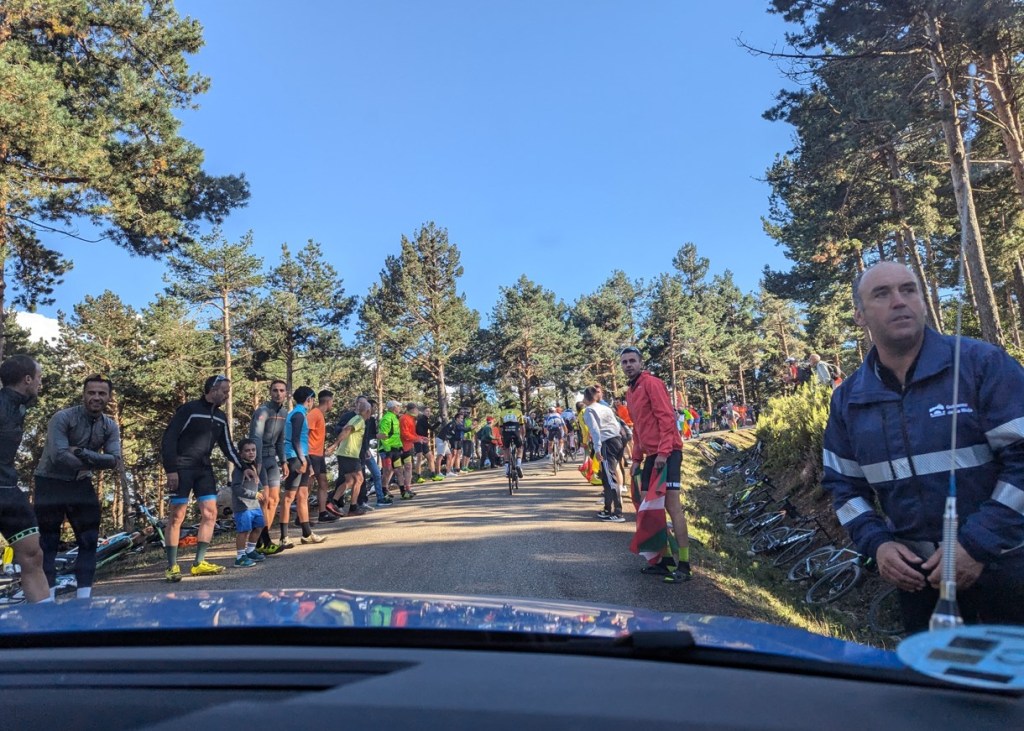
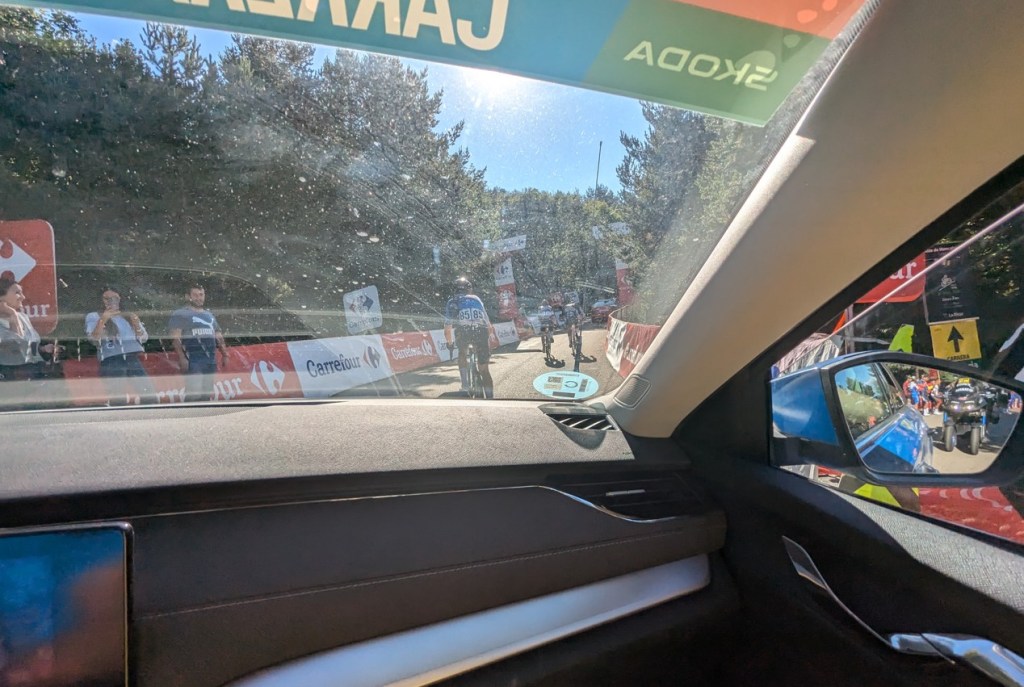

The race crescendo
Whatever the message, it seems to work. Dozens of times our Skoda passes within inches of team cars, camera bikes and even riders. And there’s not so much as a scratched wing mirror (or rider, for that matter). As the race hots up, the road narrows. And to make matters worse, the crowd are now packed onto the race course. We’re all in single file now. Riders are exploding and dropping back by the handful. But ahead the crowd closes in. They are less than a car’s width apart. It’s enough to let the riders wind their way up the climb, but there’s no way we’ll get through…
Yet surprisingly the crowd continues to part, just in time. We’re going relatively slowly now – just 15km/h, and I can hear individual members of the crowd shouting through our open window. I can even hear the labored breathing of dropped riders who start going backwards.
Then, as if it were even possible, things kick up a notch. Race radio announces there’s a split in the peloton – riders at the front have gone clear. As soon as there’s a 40 second gap between echelons or groups of riders, it’s our job to fill it. Otherwise we risk getting left behind and being no use to anyone. Our driver kicks into action, going up a gear. He pulls into what little space there is left on the road and taps out a constant rhythm on the horn. He’s on the banking now and the crowd are taking evasive action, yet he’s always in control.
La Vuelta’s defining moment
Within a minute we’re back up at the front just as the race reaches it’s crescendo. Primoz Roglic, the second placed rider overall, has gone clear and the current leader, red jersey wearer Ben O’Conner, has been dropped. This is the race-defining move that clinches the general classification (GC) for the Slovenian Bora Hansgrohe rider. Roglic is crowned Vuelta champion two days later in Madrid.
And I was almost on his wheel to see him win it.
Related content:

